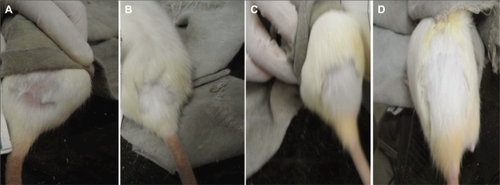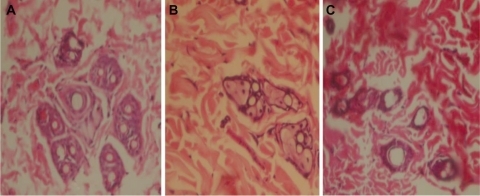Abstract
Hirsutism is a common problem in dermatology that imposes high socioeconomical costs on medical care. Consequently, researchers are actively searching for cheaper and safer methods for therapeutic treatment. The objective of the present study is to evaluate formic oil, enriched from formic acid, for the removal of unwanted hair. In this study, 32 female rats (150–200 g) were randomly divided into four groups and maintained with normal water and food availability. A patch of skin was shaved on each rat for application of test solutions. The control group was treated with local once-daily applications of normal saline. The formic acid, acetic acid, and sodium formate groups were treated with once-daily applications of formic acid (pH 5.5), acetic acid (pH 5.5), or sodium formate, respectively. After 2 weeks, horizontally cut sample biopsies were removed, and the numbers of hair follicles were counted under high field microscopy by a specialist blinded to the treatments. Kolmogorov–Smirnov test results indicated a nonparametric distribution for the rat groups. ANOVA analysis indicated no statistically significant differences between groups (P < 0.05). There weren’t any side effects or evidence for toxicity during the study period. However, hair follicle counts showed a descending order of control, acetic acid, formic acid, and sodium formate. Although the sodium formate group had the lowest hair follicle numbers, the difference was not statistically significant (P > 0.05). Formic acid was not effective in reducing hair follicle numbers in rats.
Keywords:
Introduction
Hirsutism, defined as thick male patterned hair in females, affects 5%–10% of females.Citation1 Treatment of hirsutism imposes high costs to patients. Most systematic treatments of hirsutism include anti-androgens, and although a lack of high levels of androgen can be helpful, this treatment has side effects, and its beneficial effects wear off some months after discontinuation of the treatment.Citation2,Citation3 Hair epilation, defined as temporary hair removal by waxing, shaving, and threading, has also been used for a long time. Epilation or follicle destruction has also been performed by physical methods such as electrolysis and photoepilation. However, researchers are still seeking safer and more economical methods of treatment. Therefore, permanent hair reduction by topical substances has frequently been at the center of attention. One topical treatment approved for use is eflornithine hydrochloride, which is used for face hirsutism. An ornithine inhibitor, eflornithine hydrochloride was originally used as an oral therapy to cure hyperactivity in children. A few studies have revealed that topical application of eflornithine hydrochloride can also decrease the rate of facial hair growth,Citation4,Citation5 although it does not eliminate it.Citation6 In addition, it has been used therapeutically for the use of laser epilation.Citation7 In some regions of Iran, ant oil is traditionally used to prevent unwanted hair growth.Citation8 Large desert-dwelling ants are ground up and mixed with lily or olive oil, and this oil is applied to the skin surface, where it causes hair follicle destruction and inhibition of hair growth.
In some parts of southeastern Iran, ant clay is applied to an infant’s pubic area and underarms; after puberty, the hair density in these areas is greatly reduced. In addition, cases of alopecia have been reported in the areas following ant stings.Citation9 Infrared techniques have confirmed the presence of formic acid in ant clays so its active ingredient is believed to be formic acid. Indirect support for this is provided by the fact that formic acid (also known as metanoic acid), a decalcifying agent, is used in leather factories and tanneries to remove hair from animal hides.Citation10,Citation11 Effects of formic acid were consistent with those of irritant chemicals administered by inhalation exposure in rats, and there wasn’t any substantial evidence for its systemic toxicity in female and male rats.Citation10 Based on this possibility, we decided to study the effects of formic acid and its salt on the reduction of unwanted hair. Since prolonged contact with formic acid may result in renal or hepatic damage, as well as genetic mutation, this study was carried out on rats.
Methods and materials
Formic acid and sodium formate were obtained from Sigma Aldrich (Munich, Germany). A total of 32 female rats (Fischer 344/N rats), weighing 150–200 g, were obtained from the Department of Physiology of Mashhad University of Medical Sciences, Iran. Rats were randomly divided into four equal groups. Water and suitable nourishment were available for all rats in their cages throughout the study. An area of the skin (2 cm × 2 cm above the tail area; selected due to good accessibility) was shaved, and then the test substance was topically applied to the shaved area, on a daily basis for 2 weeks. The test groups included a control group treated with normal saline, an acidity control group treated with acetic acid (pH 5.5) (controlled for effects of acidity and caustic properties), a formic acid (pH 5.5) treatment group; and a sodium formate treatment group. We considered all probable side effects including rash, redness, and swelling during the study period. They were weighed, and horizontal biopsies were taken from the center of treatment areas. Numbers of included biopsies in the evaluation process from each group are presented in . The tissues were coded, and the numbers of hair follicles were counted in three areas using a high power microscope field (HPF) by a pathologist who was blinded to the codes.
Table 1 Mean number of counted hair follicles in three HPFs of each group
Statistical analysis
All data were analyzed by the Statistical Package for Social Sciences (SPSS) for Windows™ software package (v 11.5; SPSS Inc, Chicago, IL). Data were expressed as mean ± standard deviation. A Kolmogorov–Smirnov test showed that our groups had a nonparametric distribution. Analysis of variance (ANOVA) or Kruskal–Wallis tests were used to compare variables (probable side effects and counted hair follicles) between the groups. A two-tailed P-value < 0.05 was considered statistically significant.
Results
After 2 weeks, the rats all appeared healthy without any local side effects, such as redness or swelling, or evidence of any systemic toxicity in all four studied groups. The mean number of counted hair follicles in three HPFs of each group is presented in . The sodium formate group (15.58 ± 5.6) had the lowest count for hair follicles. The total hair follicle counts, in decreasing order, were: the control group, the acetic acid group, the formic acid group, and the sodium formate group. The hair follicle counts for the acetic acid treatment were lower than for normal saline, although these differences were not statistically significant (P = 0.067). A macroscopic view of the results for each group is presented in . These figures showed that rats treated with formic acid and sodium formate had lower numbers of hairs in comparison to both control groups.
Figure 1 Macroscopic view of our studied groups: sodium format (A), formic acid (B), control with acetic acid (C), control with normal saline (D).

The microscopic follicle counts () also showed that the sodium formate group had the lowest hair follicle numbers, although this decrease was not significantly different from the other groups (P < 0.05). The formic acid and sodium formate groups had fewer hair follicles than the control group.
Discussion
Many therapeutic options are available for the treatment of hirsutism; nevertheless, no rapid treatment has yet been developed because the exact mechanism of the effects of androgens on hair follicles on different parts of the body is not yet known. The aim of hair removal therapy is permanent or prolonged hair removal until the patient is satisfied with the effect. Patients usually use temporary physical methods like shaving, depilation with tweezers, threading, waxing, or chemical substances such as depilatory creams before visiting a medical doctor.Citation12 Electrolysis, as well as laser and light-source epilation, at least hypothetically, are methods of “permanent depilation”.Citation2,Citation13 Photoepilation therapy, including the use of lasers and light sources, acts by damaging hair follicles. However, these treatments are expensive and require several sessions.Citation14
For these reasons, researchers continue to seek local, safer, more economical, and rapid therapeutic methods. Formic acid, as a simple member of the carboxylic acid family, is a colorless, volatile substance that is soluble in water, alcohol, and acetone. It is a common constituent in the stings of insects like ants and bees, as well as in nettle leaf. It is used for medical purposes and has chemical and industrial uses. Formic acid is absorbed by the skin and is oxidized to carbon dioxide and water and excreted in the urine. Formic acid application is rare in dermatological treatment; it is only used for the treatment of common warts,Citation15 where its effects may be due to dehydration and damage. In addition, it is used for nit removal after treatment by pediculocides.Citation16
In our study, toxic effects from the formic acid were not observed, nor were any side effects including redness and swelling. Also, no statistically significant differences were noted in rats treated with formic acid that could be attributed to damage to the hair follicles. However, there were apparent reductions in the numbers of hair follicles and in the hair density in the treated groups when compared with the control group. Decreased hair may be caused by caustic or dehydration properties of formic acid that has entered the follicular pore after hair removal, resulting in histological and hair follicle destruction. Therefore, we recommend further studies be directed at understanding the effects of formic acid on rat hair growth, with longer study durations.
Acknowledgements
The authors greatly acknowledge the Research Council of Mashhad University of Medical Sciences (MUMS) for financial support of the study.
Disclosure
The authors report no conflicts of interest in this work.
References
- McKnightEThe prevalence of hirsutism in young womenLancet19641733041041314092957
- MessengerAGBerkerDAKSinclairKDDisorders of hairBurnsTBreathnachSCoxNRook’s Textbook of Dermatology8th edNew YorkWiley-Blackwell2010668089
- YüceltenDErenusMGürbüzODurmuşoğluFRecurrence rate of hirsutism after 3 different antiandrogen therapiesJ Am Acad Dermatol1999411646810411413
- WolfJEJrShanderDHuberFfor the Eflornithine HCl Study GroupRandomized, double-blind clinical evaluation of the efficacy and safety of topical eflornithine HCl 13.9% cream in the treatment of women with facial hairInt J Dermatol2007461949817214730
- HoffmannRA 4-month, open-label study evaluating the efficacy eflornithine 11.5% cream in the treatment of unwanted facial hair in women using Trich ScanEur Dermatol20081816570
- Blume-PeytaviUHahnSMedical treatment of hirsutismDermatol Ther200821532933918844711
- HamzaviITanEShapiroJLuiHA randomized bilateral vehicle-controlled study of eflornithine cream combined with laser treatment versus laser treatment alone for facial hirsutism in womenJ Am Acad Dermatal20075715459
- KhosraviASina Traditional Medicine2nd edTehran Publication1995 [In Persian].
- RadmaneshMMousavipourMAlopcia induced by antsTrop Med Hyg199993427
- ThompsonMNTP technical report on the toxicity studies of formic acid (CAS No. 64-18-6) administered by inhalation to F344/N rats and B6C3F1 miceToxic Rep Ser1992191DD312209187
- SchubentDIC-07 leather processing industry – assessment of the environmental release of chemicals from the leather processing industryUmweltbundesamt Berlin1998728113
- OslenEAMethods of hair removalJ Am Acad Dermatal1999402 Pt 1143155 quiz156157
- WangerRFPhysical methods for the management of hirsutismCutis1990451926
- Alexiades-ArmenakasMRDoverJSArndtKLaser therapyBologniaJJorizzoJRapiniRDermatology2nd edSt Louis, MOMosby200813721092111
- BhatRMVidyaKKamathGTopical formic acid puncture technique for the treatment of common wartsInt J Dermatol200140641541911589750
- DeFeliceJRumsfieldJBernsteinJERoshalJYClinical evaluation of an after pediculocide nit removal systemInt J Dermatol19892874684702674043
